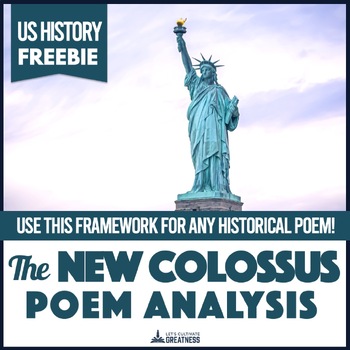- PDF
Description
Deeply analyze Emma Lazarus’s famous poem and connect to its larger historical context of the Statue of Liberty, Ellis Island, the “New” immigrants, and America’s melting pot with this everything's-included, no-prep lesson.
************************************
Greatness is appreciating the layers of poetic word in expressing a complex idea.
A poem written as a favor to raise money for a pedestal on which to display an unbelievable gift from France.
The iconic poem that almost wasn’t written.
Take your students to the backstory of Emma’s inspiration, the poetic lens on which she saw this gift, and the lasting legacy these simply lines have had on not just the Statue of Liberty, but also the meaning of America.
Introduce your students to an in-depth, yet easy way in which to examine poetry, using the DECODE method:
Definition
Emotion
Change, continuity, contrast, compare
Outside information
Denotation, connotation
Encapsulate
Included in this complete lesson:
- Lesson overview and detailed step-by-step teacher plans
- Statue of Liberty image handout for prior knowledge brainstorm
- Statue of Liberty and Colossus of Rhodes image handout for comparison activity
- “The New Colossus” text with ample annotating space
- Suggested teacher key
- -DECODE Poetry Source Analysis handout that works with ANY historical poem
************************************
Want to make this into a full unit?
- What is Our American Story: Immigration & the American Dream PBL Unit explore Ellis Island, the Great Migration, and Vietnamese Americans in this complete thematic unit
- Mini PBL Unit: Ellis Island Immigrants round out your Gilded Age or Progressive Era unit by hearing their story
Want more turn-of-the-century primary source analysis?
- Gilded Age Labor: hear the voices of those who felt unheard in this age of wealth.
- Progressive Era: learn how enough passion can turn anyone into an agent of change.
- Gilded Age: debate if Carnegie’s gospel of wealth makes society better.
- Civil Rights: compare Du Bois & Washington arguments for the same goal- equality.
Ready to upgrade your impact this year?
Purchase the U.S. History Thematic PBLBundle and teach this inquiry-driven and project-based semester course with confidence!
************************************
This listing is for one license for regular, non-commercial classroom use by a single teacher only. Commercial use like online teaching (ex. Outschool) or sharing with other teachers (ex. shared drive, in a Facebook group, in a professional development training) is strictly prohibited.
By purchasing a license to this resource, you have access to all future updates at no cost, available under “My Purchases." Multiple and transferable licenses are available for purchase. PDF files are uneditable, other files have editing abilities, unless otherwise stated. All files are protected under federal copyright laws.
To request a complete terms of use prior to purchase or if you have any questions about this resource, please leave a question below under Product Q&A.





